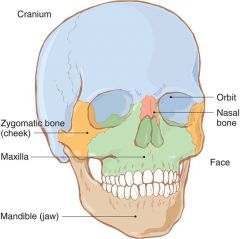![]()
![]()
![]()
Use LEFT and RIGHT arrow keys to navigate between flashcards;
Use UP and DOWN arrow keys to flip the card;
H to show hint;
A reads text to speech;
51 Cards in this Set
- Front
- Back
|
system of bones and skeletal muscles that support and protect the body and permit movement
|
musculoskeletal system
|
|
|
bones of the body
|
skeleton
|
|
|
tissue that can contract to allow movement of a body part
|
muscle
|
|
|
tissue that connects bone to bone
|
ligament
|
|
|
tissue that connects muscle to bone
|
tendon
|
|
|
bony structure of the head
|

skull
|
|
|
top, back, and sides of the skull
|
cranium
|
|
|
the lower jaw bone
|
mandible
|
|
|
two fused bones forming the upper jaw
|
maxillae
|
|
|
nose bones
|
nasal bones
|
|
|
bony stucture around the eyes, eye sockets
|
orbits
|
|
|
form the structure of the cheeks
|
zygomatic arches
|
|
|
33 bones of the spinal column
|
vertebrae
|
|
|
5 sections of the spine
|
cervical, thracic, lumbar, sacral, coccyx
|
|
|
neck (7 vertebrae)
|
cervical
|
|
|
thorax, ribs, upper back ( 12 vertebrae)
|
thoracic
|
|
|
lower back (5 vertebrae)
|
lumbar
|
|
|
back wall of pelvis (5 vertebrae)
|
sacral
|
|
|
tailbone (4 vertebrae)
|
coccyx
|
|
|
the chest
|
thorax
|
|
|
the breastbone
|
sternum
|
|
|
superior portion of the sternum
|
manubrium
|
|
|
inferior portion of the sternum
|
xiphoid process
|
|
|
basin shaped bony structure that supports the spine and is the point of proximal attachment for the lower extremities
|
pelvis
|
|
|
superior and widest portion of the pelvis
|
ilium
|
|
|
lower, posterior portions of the pelvis
|
ischium
|
|
|
pelvic socket into which the ball at the proximal end of the femur fits to form the hip joint
|
acetabulum
|
|
|
large bone of the thigh
|
femur
|
|
|
the kneecap
|
patella
|
|
|
the medial and larger bone of the lower leg
|
tibia
|
|
|
the lateral and smaller bone of the lower leg
|
fibula
|
|
|
protrusion on the side of the ankle
|
malleolus
|
|
|
lower end of the fibula, seen on the outer ankle
|
lateral malleolus
|
|
|
lower end of the tibia, seen on the inner ankle
|
medial malleolus
|
|
|
ankle bones
|
tarsals
|
|
|
foot bones
|
metatarsals
|
|
|
heel bone
|
calcaneus
|
|
|
toe and finger bones
|
phalanges
|
|
|
collar bone
|
clavicle
|
|
|
shoulder blade
|
scapula
|
|
|
the highest portion of the shoulder
|
acromion process
|
|
|
joint where the acromion and clavicle meet
|
acromioclavicular joint
|
|
|
bone of the upper arm, between shoulder and elbow
|
humerus
|
|
|
lateral bone of the forearm
|
radius
|
|
|
medial bone of the forearm
|
ulna
|
|
|
wrist bones
|
carpals
|
|
|
hand bones
|
metacarpals
|
|
|
point where two bones come together
|
joint
|
|
|
muscle that can be consciously controlled
|
voluntary muscle
|
|
|
muscle that responds automatically to brain signals but cannot be consciously controlled
|
involuntary muscle
|
|
|
specialized involuntary muscle found only in the heart
|
cardiac muscle
|

